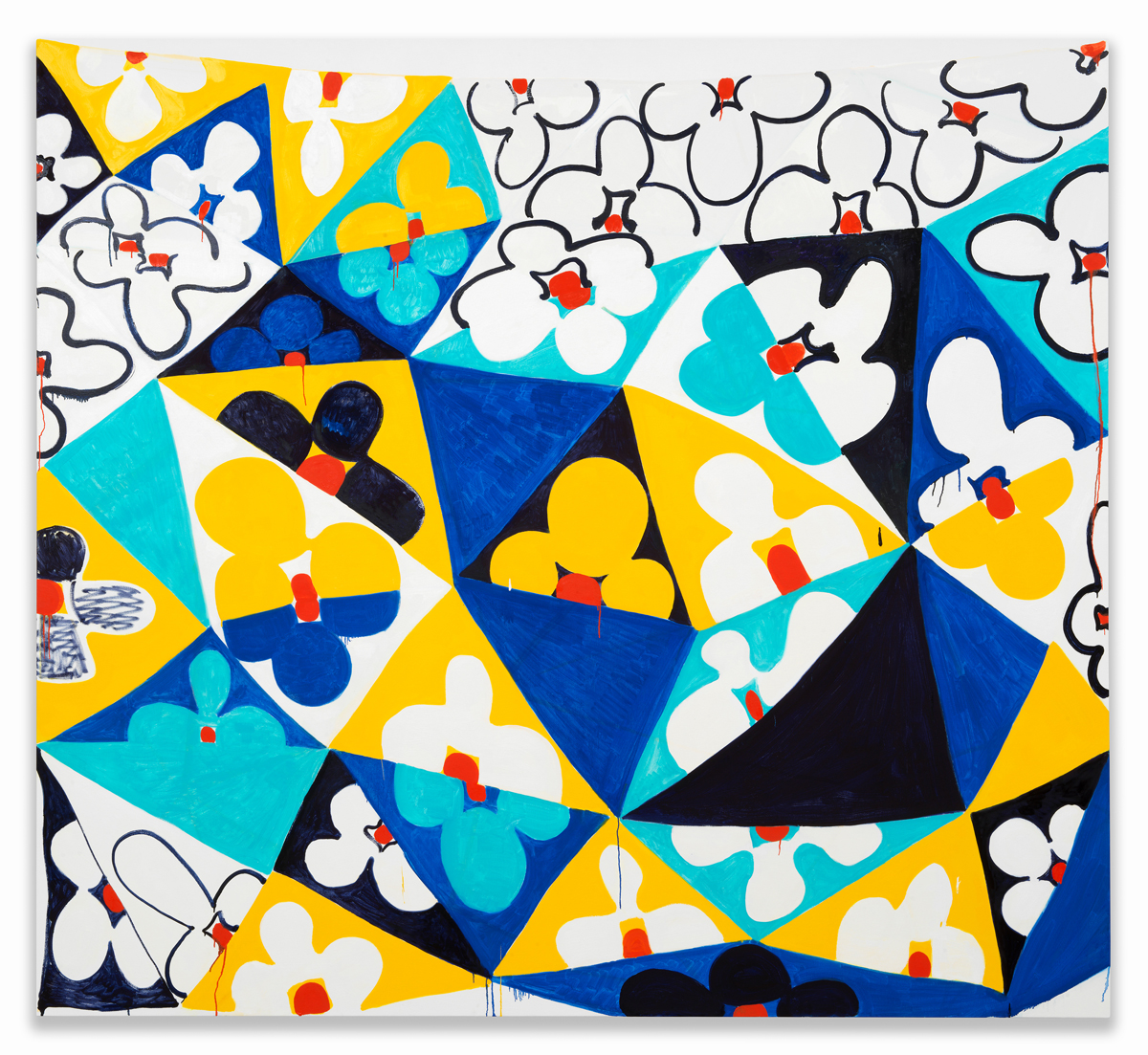Judy Ledgerwood: Sunny
By Mána Taylor
Feb 1, 2023
In her exhibition Sunny, Judy Ledgerwood has bold intentions. She began working on the paintings last January when she was searching for color during many gray days. At Denny Gallery, the paintings, as well as one large ceramic in the back of the gallery, feel necessary. They are large, most of them ranging between 60 and 80 inches tall. Yet, Ledgerwood is able to make us feel like the paintings could be larger, as if she cropped a pattern and is only revealing a small part of it. This is also due to the fact that she leaves room at the top, a curved white space, making her painted patterns look like fabric, or laundry hanging from a thread.
Ledgerwood lives in Chicago, where she has been exhibiting art since the late eighties. Her work began as an exploration of colorful hues, but she shifted to pattern-making when she felt that what she was painting was too beautiful. She told me that she now embraces the clash between beauty and vulgarity and strives for disruptions. Though her work is defined by repetitions of patterns, inspired partly by her quilt-making grandmothers, the repetition is never perfect. The four-leafed pattern that is prominent in many of her paintings in Sunny is a simplification of a flower: four curved lines, a circle in the middle.
Ledgerwood defies the constraints of the canvas: wrapping her patterns around the edges, applying thick impasto marks squeezed directly out of her paint tube, and allowing for a certain spontaneity to occur when the paint drips. She is capable of making oil paint appear like a silk scarf floating in nothingness. Sunny was also conceived as a way to connect with variations on red, yellow, and blue. Her painting Footsteps (all works 2022) consists of the same flower pattern split into three color sections. A yellow panel on the left side, followed by blue outlines over bright red in the middle, and black flowers on top of a bright shade of blue on the right. It is reminiscent of the time when Ledgerwood had a research grant to study light and architecture in Morocco and found herself enamored with broken ceramics that were glued together to make new patterns.
 Judy Ledgerwood, Footsteps, 2022. Oil on canvas, 72 x 48 inches. Courtesy the artist and Denny Gallery, New York.
Judy Ledgerwood, Footsteps, 2022. Oil on canvas, 72 x 48 inches. Courtesy the artist and Denny Gallery, New York.
From afar, her use of oil paint seems to be tricking itself to look like thin fabric; up close, the thick textures of brushstrokes and impasto are charming exaggerations made by an artist dedicated to the potential of shape. The flower shape morphs and grows and repeats itself until, as in her painting Jaywalking, it seems she has pushed herself toward the edge. The flowers don’t exactly look like flowers anymore; some resemble orange suns setting behind water, others like silhouettes of an upper body. There is a blend of filled-in colors and hand-drawn shapes, clashing in proportion—as if there is a “tug of war” happening with a quilt, and the squares are stretched in multiple opposing directions.
 Judy Ledgerwood, Jaywalking, 2022. Oil on canvas, 84 x 96 inches. Courtesy the artist and Denny Gallery, New York.
Judy Ledgerwood, Jaywalking, 2022. Oil on canvas, 84 x 96 inches. Courtesy the artist and Denny Gallery, New York.
In Plato’s Primaries, she disregards the flower shape for a checkered pattern, red squares over a yellow background. Suddenly, I noticed that she was hiding secrets in the squares. A smaller square of lavender appears as well as a dark purple, as if a flower is growing between the cracks of the sidewalk. Interrupting her own patterns is her strong suit. Unlike early modernist paintings where there is a sense of no-time, Ledgerwood wants the drips from the paint and the clashes of colors to make her work breathe and morph as an active phenomenon, her paintings come to life and exist in actual time, like a flower blooming in full sun.
 Judy Ledgerwood, Plato’s Primaries, 2022. Oil on canvas, 44 x 38 inches. Courtesy the artist and Denny Gallery, New York.
Judy Ledgerwood, Plato’s Primaries, 2022. Oil on canvas, 44 x 38 inches. Courtesy the artist and Denny Gallery, New York.
